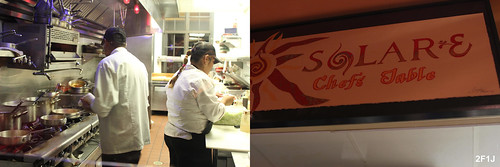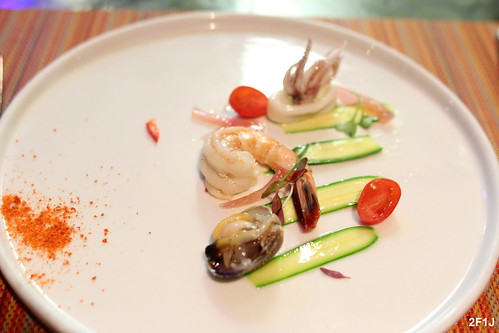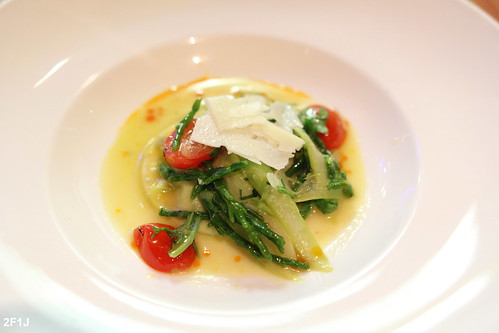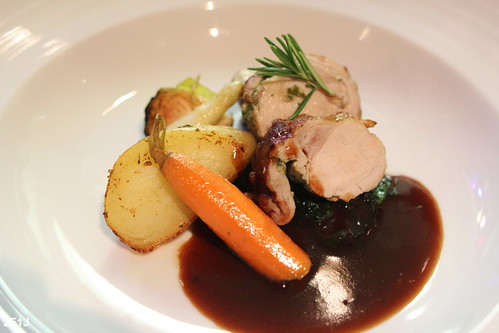The origin
of tasting menus is quite obscure and there are many different theories going
as far back as to the Ancient Greeks and Romans who have been reported to serve
multi-course menu consisting of 16-20 dishes. Individual courses might not have
been as sophisticated as those of today’s cuisine, but these “tasting menus”
already showed a similar progression that we are used to seeing today. Another
important historic influence were traditional Japanese Kaiseki menus with their
specific order, focus on seasonality, and elaborate presentations, highly
reminiscent of today’s Western tasting menus - Thomas Keller cites them as a
significant influence as “the Kaiseki dinner is very similar to the way we
serve food in the French Laundry”. Over the last century, tasting menus were heavily
influenced by French cuisine, and Escoffier is often credited as having
“invented” tasting menus in modern times while working at the Ritz hotels. The
French influence is also apparent with chefs like Paul Bocuse in France, and Thomas
Keller in the US, who were both at the forefront to establish tasting menus at
their restaurants and who thereby had a tremendous influence on later
generations of chefs. Tasting menus present a unique opportunity for chefs to
represent their individual cuisine and philosophy. However, except for French
restaurants and those influenced by Modernist Cuisine, tasting menus are not
that common to find on other types of cuisine.
Chef
Accursio Lota was born in Menfi, a small town in Sicily, and was exposed to fresh
ingredients and cooking early on in life as both his mother and grandmother
used fruits and vegetables from their own garden, fish from the local sea, and
olive oil harvested and produced from their own olive trees. So it seems like a
natural progression that he ended up graduating from culinary school. One of
his most influential, early mentors was Chef Sergio Mei at the Four Seasons
Hotel Milan where Chef Lota was able to dive deep into the Italian culinary
tradition. But Chef Mei was also instrumental in motivating him to move to
California to work at the Biltmore Four Seasons Hotel in Santa Barbara which
gave him a different perspective to cooking. Not unlike in Sicily, the Biltmore
kitchen also focused on local produce with Mediterranean flavors, but it also
incorporated numerous other influences from the melting pot of California. In
2009, he returned to Sicily to work as Sous Chef at Hotel Imperiale in Taormina
where, for the first time, he had the culinary freedom to develop his own
style. In 2011, Chef Lota moved back to California to join Chefs Guillas and
Oliver as Sous Chef at the Marine Room which gave him a wide exposure to fusion
cooking. In 2012, he decided to fine tune his personal cooking style even more
by starting Limone, an underground restaurant, focusing on multicourse dinners.
In the same year he accepted the offer from owner Randy Smerik to join Solare
as Executive Chef.
Solare was
started in 2008 by Chef Stefano Ceresoli and his wife Roberta Ruffini, but
in2012 the couple decided to sell Solare to only focus on their other
restaurant at that time, Caffe Bella Italia in Pacific Beach. They recently
closed the latter one as well to start Piazza 1909 in La Jolla. Solare was
bought by Randy Smerik, and his two sons Brian and Tommy Smerik. Randy Smerik
has an unusual background for a restaurant owner as he had originally worked in
the IT field for 25 years, including being a vice president at Intel, a founder
and CEO of Tarari and Osunatech, but he is also on the Board of Directors for
Fortaleza Tequila. Since offering Chef Lota the Executive Chef’s position at
Solare, he has given him free hand to realize his cooking style which also
included implementing an Italian inspired 9-course
tasting menu.
Solare has a
rather unique set up for their tasting menu which is served at the Chef’s
Table. The Chef’s Table is a kitchen counter with two bar stools and a perfect
view of the action in the kitchen. These types of kitchen counter/Chef’s tables
are one of our favorite ways to dine as it gives you a very close look to the
processes of the kitchen, and interaction of the chefs and cooks.
1st
Course: Shrimp, squid, clam, zucchini carpaccio, onion confit, tomato,
caperberry, dehydrated lobster broth
Three
impeccable pieces of seafood were the stars of this plate and showcasing the
variety of flavors and textures of seafood, ranging from tender and subtly
flavored squid to soft and briny clams. Instead of the obligatory lemon, caper berries,
tomatoes and onion confit added some desired acidity to the dish. The
dehydrated lobster broth sprinkled over the seafood added some salinity and
enhanced the natural flavors.
2nd
Course: Squash blossom, ricotta, mint pesto, pomodoro sauce
One of the
classical Italian appetizers which is often served with greasy, soggy blossoms,
tasteless ricotta and drowned in sauce. Here we had a prime example how to make
it right – flavorful homemade ricotta was wrapped in a delicate squash blossom
which allowed us to taste the floral flavor. Small dots of slightly acidic
tomato sauce and herbal, but not overpowering, mint pesto helped to accentuate
the dish yet provided a playful way to mix and match different flavor
combinations so that every bite was different – a beautiful dish.
3rd
Course: Carpaccio di Wagyu, wagyu beef sirloin, borrage flowers, arugula,
Parmigiano Reggiano, rosemary salt, balsamico pearls
The wagyu
beef carpaccio had a surprisingly strong, pleasant beefy flavor, whereas the
arugula provided some textural contrast, and the Parmigiano added the necessary
saltiness. We liked the idea of adding the acidity by balsamico pearls instead
to just some liquid amount of acetic balsamico as it was much easier to include
the desired amount of balsamico in each bite which gave way to a perfect balance
of salty, bitter, acidic and Umami.
4th
Course: Risotto, vino bianco, scorza di limone, squid ink reduction, scallop
The risotto
had the perfect consistency of creaminess with some bite from the al dente rice
corns. The mixture of white wine, lemon marmalade and squid ink gave a very
interesting combination of bitterness and acidity from the wine and marmalade
with the savori- and saltiness of the squid ink. All these flavors worked
really well with the beautifully seared scallop.
5th
Course: Ravioli with ricotta & spinach, cherry tomatoes, asparagus, sea
beans, pecorino
Pasta can be
such a simple and yet difficult dish – just semolina, eggs and water - but
rarely do you find such delicate finished pasta like in this dish - substantial
yet thin enough that it didn’t overpower the filling of the homemade ricotta
and spinach. The lightness of the dish continued with the accompanying
vegetables like asparagus, tomatoes and sea beans. By far not the only dish
where we wished we could get a second helping.
6th Course: Tuna, broccolini, fingerling potatoes, nostralina olives, limoncello, special olive oil, sea asparagus
6th Course: Tuna, broccolini, fingerling potatoes, nostralina olives, limoncello, special olive oil, sea asparagus
A rather
classic dish with the combination of tuna, broccolini, potatoes and olives –
well executed dish with moist fish, not overcooked broccolini - but what really elevated it was the olive oil
Chef Lota added at the table – DOP Val di Mazara from his home town. A very complex
olive oil with notes of pistacchio, citrus and artichoke, and a low acidity
which brought the dish together.
7th
Course: Rabbit loin, carrots, kale, potato, brussel sprout, demi glace
Rabbit is
often decried as being as tasteless as badly prepared chicken, but in this dish
the rabbit loin had a nice distinct meaty, slightly sweet flavor which stood up
surprisingly well against the other ingredients. This dish was another example
of the ability of Chef Lota to create very complex but yet balanced flavor
profiles in his dishes spanning from sweetness by the carrots, to bitterness by
the brussel sprouts and kale, to Umami by the demi glace.
8th Course: Pistacchio crusted rack of lamb, lamb loin, potato-saffron timbale, pickled cipollini, pesto
8th Course: Pistacchio crusted rack of lamb, lamb loin, potato-saffron timbale, pickled cipollini, pesto
Placing the
pesto in the middle of the plate clearly indicated the overarching theme of the
dish. The pesto worked equally well with all other components – lamb loin, rack
of lamb and potato-saffron timbale and connected these parts to a coherent
finish of the savory part of the tasting menu.
9th Course: Chocolate mousse, crispy almonds, candies pistacchios, berries, orange peel, amaretto cherry
9th Course: Chocolate mousse, crispy almonds, candies pistacchios, berries, orange peel, amaretto cherry
The combination
of fruits and chocolate ensured that the night didn’t end in an overly heavy
dessert. The different nut preparations reminded us of some type of granola,
and the dish was a continuation of the savory courses – excellent execution
with very balanced flavors.
Every
cuisine is associated with certain attributes which are obviously often strong
generalizations since there is no such thing as a singular type of cuisine: every
country has many regional or even local variations. French cooking is often described
as complex and relying on technique and elaborated sauces, whereas Italian food
is more focused on simpler dishes which let seasonal ingredients shine. Chef
Lota impressed us with how he was able to capture this general “Italian”
philosophy throughout the tasting menu, but at the same time was able to
instill his own style. He presented us each course explaining the seasonality
and the local farms where the ingredients came from, and with his thoughts on
how the different components of the dish should work together. Focusing on few
key ingredients in each dish required flawless execution of each of them. What
really made all these dishes stand out, and seems to be a reflection of his
style, was the complexity and yet effortlessness of the seasoning of the
dishes. Many dishes had seemingly secondary components, like for example the
dehydrated lobster broth or Val di Mazara oil which was essential in bringing
the dishes together. Or dishes like the risotto were the combination of scorza
di limone and squid ink reduction created something greater than the sum of its
parts.
This tasting menu was a prime example how the menu format of a tasting menu allows a talented chef to showcase the cuisine from his/her native country, yet instilled with his/her own interpretations. We wish more chefs, especially from ethnic restaurants, would use this concept to present the many facets of their cuisines. We are looking forward to follow Chef Lota in his interpretations of Italian cuisine throughout the seasons.














